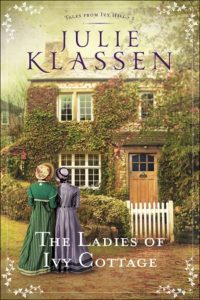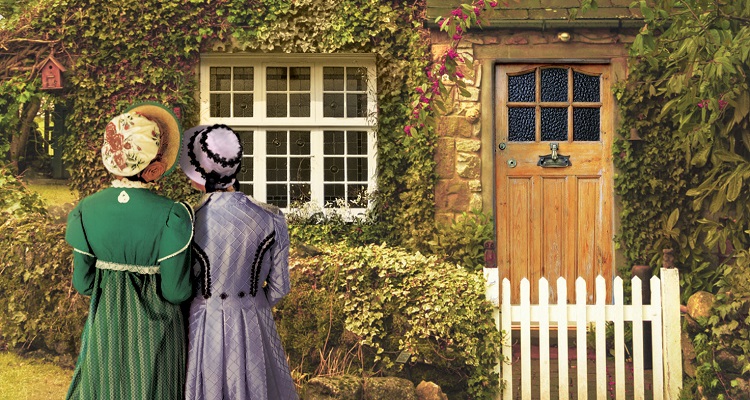Julie Klassen continues her Ivy Hill series with The Ladies of Ivy Cottage (Bethany House), which returns readers to 1800s England. Mercy Grove has given up thoughts of suitors and finds fulfillment in managing her girls school. But when several men take an interest in Ivy Cottage, what–or whom–has captured each man’s attention? The truth may surprise them all. In this interviews, Julie shares about the new book, where she got the idea for the series, and the challenges of writing her first sequel…
 What can you tell us about your new book, The Ladies of Ivy Cottage?
What can you tell us about your new book, The Ladies of Ivy Cottage?
The Ladies of Ivy Cottage is the second book in the Tales from Ivy Hill series. In it, Rachel Ashford finds herself living with her friend Mercy Grove but without a way to support herself. Jane Bell and others encourage her to open a circulating library with the many books she’s inherited.
As villagers donate additional books, Rachel discovers mysteries hidden among them. A man who once broke her heart helps her search for clues, but both find more than they bargained for. Meanwhile, Mercy Grove has given up thoughts of suitors and finds fulfillment in managing her girls school. So when several men take an interest in Ivy Cottage, she assumes pretty Miss Ashford is the cause. But the truth may surprise them all.
Where did you get the original idea for this series?
I have wanted to write a village-based series for years. As an author of historical fiction set in England, I have loved several BBC miniseries set in villages like Larkrise to Candleford, Cranford, and Middlemarch, as well as the Thrush Green series of books. I am drawn to their close-knit communities filled with unforgettable characters, romance, family drama, and of course, the British accents. Now I hope readers will enjoy the Tales from Ivy Hill series as well.
This is the first sequel or “Book Two” you have written. What unique pleasures or challenges did you face while writing it?
Both! Pleasure-wise, I enjoyed staying in the same village for a second book, going deeper with the main characters, and bringing more secondary characters to life. As far as challenges, I found it tricky to decide how far to move the story forward to make Book Two fully satisfying while also (hopefully) enticing readers to read the third and final book next year.
Finding the right balance of each character’s story was also a challenge. It’s not surprising there was a learning curve, as I’ve never written a series before. Kudos to veteran series writers who make it look so easy! Thankfully, I have talented critique partners and editors who helped me hone the book. I truly think readers will enjoy it even more than Book One.
Is Ivy Hill a real place?
 Ivy Hill is fictional, but it is based on a real place: the national trust village of Lacock in Wiltshire. (In fact, there is a map of Ivy Hill printed in the book, and the street layout is nearly identical to Lacock’s.) I’ve had the pleasure of visiting Lacock three times now, most recently in September 2017, when I hosted my first-ever group trip to England. What a pleasure to tour Lacock’s half-timbered buildings, ivy-covered stone cottages, tempting shops, inns, and eateries with people who had read the book. I think they were as charmed by the place as I was.
Ivy Hill is fictional, but it is based on a real place: the national trust village of Lacock in Wiltshire. (In fact, there is a map of Ivy Hill printed in the book, and the street layout is nearly identical to Lacock’s.) I’ve had the pleasure of visiting Lacock three times now, most recently in September 2017, when I hosted my first-ever group trip to England. What a pleasure to tour Lacock’s half-timbered buildings, ivy-covered stone cottages, tempting shops, inns, and eateries with people who had read the book. I think they were as charmed by the place as I was.
And I am not the first to set something there. Lacock has been used as a film location for scenes in Pride & Prejudice (1995), Cranford (2007), Emma (1996), and several other productions.
The first book was set primarily in a coaching inn. What is the setting of Book Two?
The primary setting of the book is a house called Ivy Cottage, where Mercy runs a small girls school and Rachel opens a circulating library. Books were very expensive in those days and free public libraries did not yet exist in Great Britain. But by the early nineteenth century, circulating libraries were thriving businesses found in most major English cities. These libraries charged an annual subscription fee that would allow subscribers to check out a certain number of volumes in a given period. As a book and history lover, I enjoyed incorporating a few details about these forerunners to today’s public libraries.


